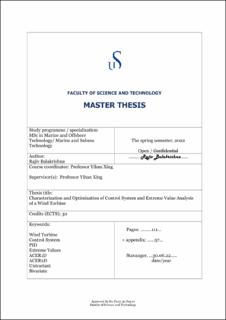| dc.description.abstract | The global hunger for energy has only been rising every day as we progress more into adopting superior and better technology to make lives better and easier. As more countries tread the path of industrialization, the need for cleaner and greener energy is imperative to reduce damage to an already deteriorating environment. Wind energy accounts for about 15% of renewable energy and is one of the fastest-growing renewable technologies. The energy produced by wind has doubled in the past decade. The wind industry is only expected to grow with an infinite supply of natural wind. Wind turbines in the 1980s had a capacity of 0.1MW, but today they average at around 10MW, with the largest wind turbines having a capacity of 15MW. Due to a surge in demand and potential for growth, it has become more critical than ever to find newer strategies to maximize turbine efficiency. Numerous approaches can be adopted to improve a turbine's efficiency, including design, material, or control system changes. Other options include using novel or better prediction models to estimate extreme values that can be useful in fine-tuning designs of wind turbines. In this thesis, two main strategies are adopted in an attempt to optimize the efficiency of wind turbines. Firstly, in Paper-I, a novel change to the pitch controller is adopted by adding and optimizing the bending moments to reduce the bending moment in the low-speed shaft. A reduction in the bending moment will reduce the internal drive train loads within the gearbox, thus extending its lifespan. A reduction of bending moment with minimal loss in shaft rotational speed was observed through this optimization. While in, Paper-II and -III, the novel ACER1D and 2D (univariate and bivariant analysis) models were used to estimate extreme load values. Paper-II presented the ACER1D results but focused on the ACER2D as it fitted it against other models, such as the optimized Asymmetric and Gumbel logistic models. This paper showed that ACER2D was advantageous since it could produce very accurate results compared to the other models with very little data set. While in Paper-III, extreme values estimate from ACER2D were compared against the Gumbel model, and the results obtained were positive, showing that ACER1D was better at estimating extreme values with a small data set. Optimizing the extreme values is critical when designing wind turbines as proper values enable better and more reliable turbine designs. Thus, both the strategies adopted in this thesis showed that through proper optimization, a reduction of load or a better design could be achieved, resulting in better efficiency in wind turbines. | |
